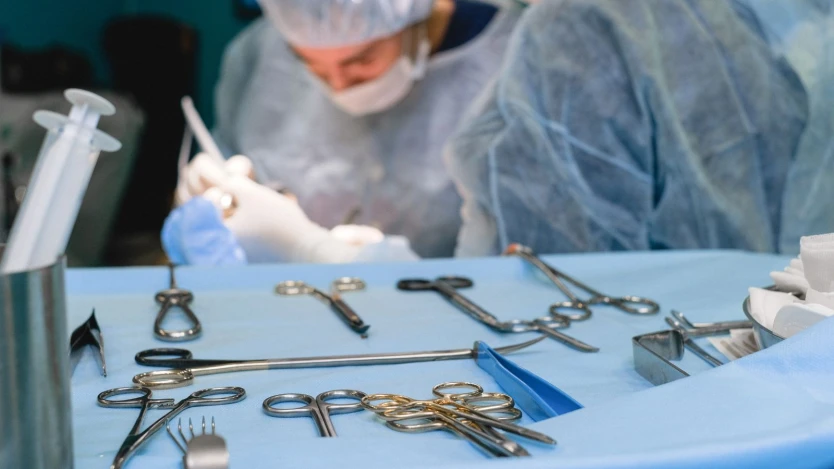What is a laparoscope and what is it used for?

- What is a laparoscope?
- What is the history of the laparoscope?
- What is the laparoscope used for?
- In which surgeries is the laparoscope used?
- What are the advantages of laparoscopy?
- The laparoscope allows minimally invasive surgery to be performed in the pelvic-abdominal area without the need for open surgery.
- The use of the laparoscope is very common in general and gynaecological surgery, particularly gallbladder removal and myomectomy.
- Recovery after laparoscopic surgery reduces recovery time considerably.
What is a laparoscope?
The laparoscope is a surgical instrument used to observe the inside of the abdominal and pelvic cavity during surgery.
It consists of a light source transmitted from the source to the laparoscope by fibre optics, a video equipment with corresponding monitors to visualise and record the operation and the part that is inserted into the abdominal cavity.

Free Assessment for Contracting Medical Services
Operarme’s Patient Service will contact you and solve all your questions on the medical service you need.
Although this instrument is specifically designed for insertion into the pelvic-abdominal cavity, similar models exist for surgeries related to the thorax (thoracoscope) and for joint surgeries (arthroscope).
These instruments are used in the same way as the laparoscope, with variations mainly in the size of the device.
What is the history of the laparoscope?
Already in ancient Greece, humans began to explore the internal organs by means of instruments developed for this purpose.
In the ruins of the city of Pompeii, artefacts were also found that allowed vaginal exploration, similar to those we use today.
However, the first instrument resembling what we know today as a laparoscope was discovered in 1805 by Dr. Philipp Bozinni, who presented a light-conducting instrument that obtained images of the inside of the human body by reflecting on lenses designed for this purpose.

Free Assessment for Contracting Medical Services
Operarme’s Patient Service will contact you and solve all your questions on the medical service you need.
This instrument was only tested on animals until 1853, when it was perfected by the surgeon Antoine Jean Desormeaux and the first test on humans was carried out.
The biggest problem with its use was the burns it produced, as the light source came from a paraffin lamp. Its first uses were for examination of the female reproductive organs.
Over the years, numerous celebrities such as Thomas Edison have contributed their improvements to the laparoscope, mainly in terms of the method of light transmission and image viewing.
It was in 1911 that the first incision was made in the thoracic cavity of a human being to introduce the device, extending its uses from the gynaecological study it was originally intended for.

In 1974, fibre optic light was used for the first time, as it is used today, and in 1986 the first mini-camera was introduced, which allowed the use of external monitors where the surgical procedure could be observed with total precision. Today, the quality of recording and reproduction has evolved enormously, so that the technology used in the laparoscope is much smaller and the process is recorded in HD and even with 3D technology.
What is the laparoscope used for?
Laparoscopy is a minimally invasive intervention that allows observation of the inside of the abdominal area through a small incision in the abdominal wall, through which the laparoscope is introduced (avoiding open surgery).
For this reason, it is also used to diagnose pain in the abdominal or pelvic area in cases where X-rays are not clear. It is also very useful in the treatment of cancer, as it is possible to observe whether new tumours have appeared (metastases).
In which surgeries is the laparoscope used?
Historically, the laparoscope was first used for the observation of the female reproductive tract and later in gynaecological surgery, such as tubal ligation, as well as in gallbladder surgery.
Today, this technique can be used in practically all abdominal and pelvic surgeries, such as pancreatectomies, appendectomies, cystectomies, cancer, colitis, sterilisations, rectal prolapse, ulcers, severe constipation, etc.
Among them, the most common interventions are the following:
Laparoscopic surgeries of general surgery and the digestive system
- Laparoscopic cholecystectomy surgery. The laparoscopic cholecystectomy surgery consists of the removal of the gallbladder, affected by gallstones or other pathologies, through 2 or 3 incisions made in the abdomen, through which the laparoscope is introduced, through which the surgeon will observe the inside of the abdominal cavity, as well as the surgical instruments for the extraction. This procedure reduces the recovery time considerably.
- Laparoscopic hernia surgery. This surgery consists of repairing a hernia from inside the abdomen. Conventional surgery is performed from the outside by open surgery, placing the surgical mesh from the outside. In the case of laparoscopic surgery, the surgeon performs the operation from inside the abdomen, which improves post-surgical recovery times.

Laparoscopic gynaecological surgery surgeries
- Laparoscopic hysterectomy surgery. This intervention involves the removal of the woman's uterus without open surgery, which allows for a much quicker recovery. It is a surgery performed for serious problems, such as tumours or large, multiple fibroids. To find out more about hysterectomy by laparoscopy you can visit this link: Laparoscopic hysterectomy
- Laparoscopic myomectomy surgery. Laparoscopic myomectomy allows the surgeon to perform minimally invasive removal of fibroids in the uterus. The best way to understand this surgery is to read the step-by-step guide to laparoscopic myomectomy.
What are the advantages of laparoscopy?
Laparoscopic surgery has many advantages in terms of patient management. Laparoscopy has become the first choice in many operations by reducing many of the risks associated with conventional open surgery.
Firstly, while in conventional surgery a single incision is made from which the operation is performed, in laparoscopy several smaller incisions are made, allowing the surgeon to carry out his work.
Since laparoscopic surgery involves much less surface area damage than open surgery, the patient's postoperative pain is significantly reduced, as well as the possibility of the wound becoming infected or creating a hernia.
Consequently, the patient recovers from the operation much more quickly, reducing the time spent in hospital and care at home, and can return to normality in a much shorter period of time than after open surgery.

On the other hand, the instruments used in laparoscopy are smaller and more delicate, so that less tissue and intestine are manipulated, resulting in less blood loss for the patient and less disruption of the body's immune mechanisms.
Finally, the difference in aesthetics between laparoscopic surgery and conventional open surgery is remarkable. Laparoscopic surgery results in a much smaller scar than conventional surgery, so the final aesthetic result for the patient is much better.

Free Assessment for Contracting Medical Services
Operarme’s Patient Service will contact you and solve all your questions on the medical service you need.
Medical disclaimer: All the published content in Operarme is intended to disseminate reliable medical information to the general public, and is reviewed by healthcare professionals. In any case should this information be used to perform a diagnosis, indicate a treatment, or replace the medical assessment of a professional in a face to face consultation. Find more information in the links below:
